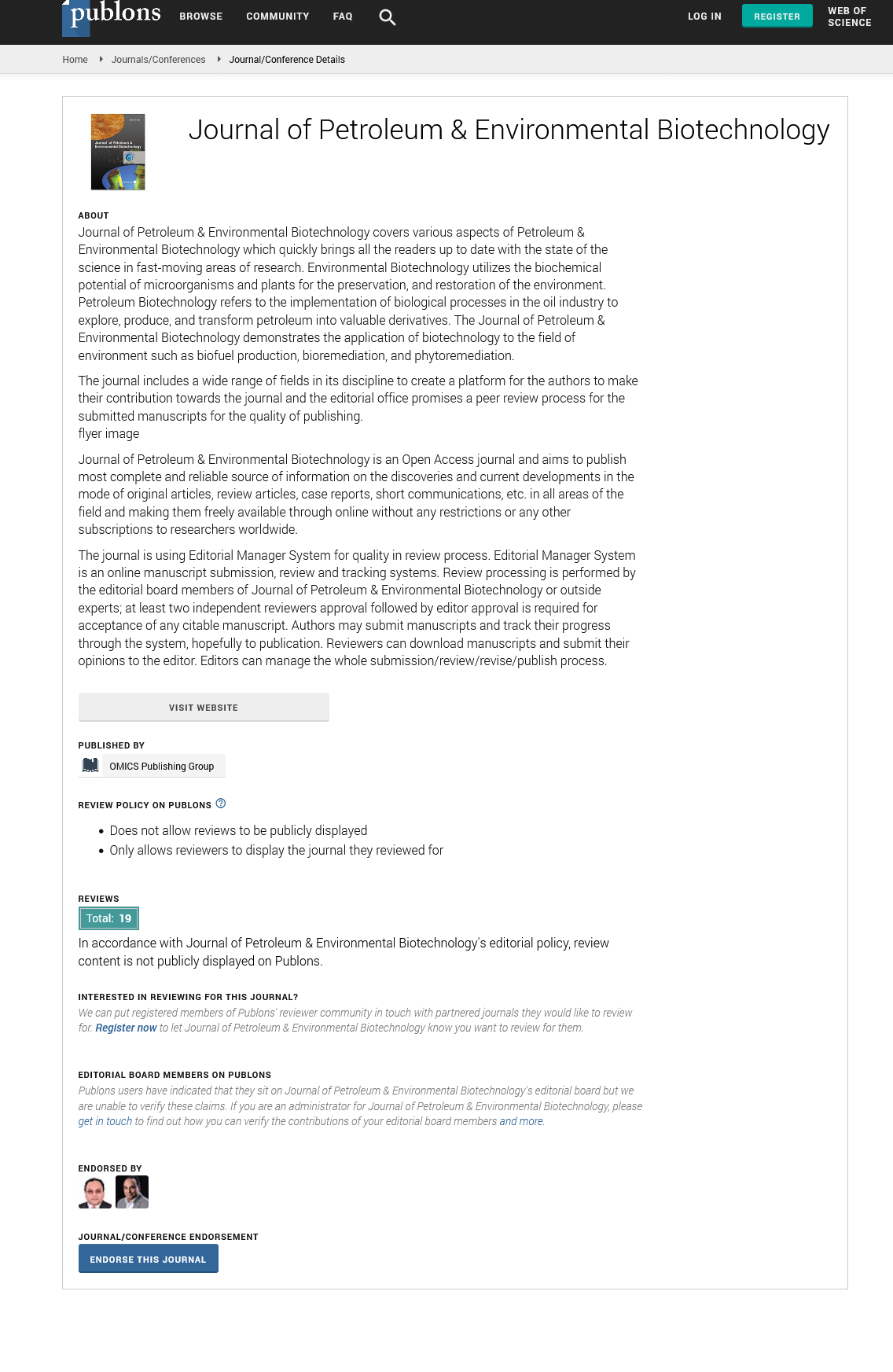Indexed In
- Open J Gate
- Genamics JournalSeek
- JournalTOCs
- China National Knowledge Infrastructure (CNKI)
- Electronic Journals Library
- RefSeek
- Hamdard University
- EBSCO A-Z
- OCLC- WorldCat
- SWB online catalog
- Virtual Library of Biology (vifabio)
- Publons
- MIAR
- Euro Pub
- Google Scholar
Useful Links
Share This Page
Journal Flyer

Open Access Journals
- Agri and Aquaculture
- Biochemistry
- Bioinformatics & Systems Biology
- Business & Management
- Chemistry
- Clinical Sciences
- Engineering
- Food & Nutrition
- General Science
- Genetics & Molecular Biology
- Immunology & Microbiology
- Medical Sciences
- Neuroscience & Psychology
- Nursing & Health Care
- Pharmaceutical Sciences
Perspective - (2024) Volume 15, Issue 4
Innovations in Petroleum Geochemistry: Enhancing Exploration and Reducing Environmental Footprints
Patelex Damson*Received: 25-Nov-2024, Manuscript No. JPEB-24-27953; Editor assigned: 29-Nov-2024, Pre QC No. JPEB-24-27953 (PQ); Reviewed: 13-Dec-2024, QC No. JPEB-24-27953; Revised: 20-Dec-2024, Manuscript No. JPEB-24-27953 (R); Published: 27-Dec-2024, DOI: 10.35248/2157-7463.24.15.592
Description
Petroleum geochemistry is a specialized branch of geochemistry that focuses on the study of the chemical composition of petroleum and its components. It is essential for understanding the origin, migration and accumulation of oil and natural gas, as well as their potential environmental impacts. By studying the chemical signatures of oil and gas, scientists can gain critical insights into reservoir characteristics, improve exploration techniques and help predict the behavior of hydrocarbons within geological formations. Petroleum geochemistry has evolved significantly over the years, playing a essential role in the petroleum industry by assisting in exploration, production and environmental monitoring.
Petroleum, commonly known as crude oil, is primarily composed of hydrocarbons organic compounds made up of hydrogen and carbon. These hydrocarbons are derived from ancient organic matter, including plant and animal remains that were buried and subjected to heat and pressure over millions of years. The geochemical process begins with the accumulation of organic material in sedimentary basins, which are typically rich in microorganisms, plants and algae. As this material is buried by layers of sediment, it is subjected to increasing temperatures and pressures, leading to the formation of kerosene a precursor to petroleum.
Over time, as the temperature and pressure continue to rise, the kerosene undergoes a process known as catagenesis, which breaks it down into liquid and gaseous hydrocarbons. This process is known as maturation and it forms the basis of oil and gas generation. The type of kerosene, the temperature at which it matures and the specific geological conditions play a significant role in determining the composition of the resulting petroleum, including its chemical structure and physical properties.
Geochemical techniques are employed to investigate the properties and distribution of petroleum within geological formations. One of the most widely used methods in petroleum geochemistry is the analysis of source rock geochemistry. Source rocks are the rocks in which hydrocarbons are generated and their chemical composition provides valuable information about the petroleum that may be derived from them. The analysis of source rocks involves the measurement of biomarkers organic compounds found in petroleum and source rocks that are unique to specific types of organisms. These biomarkers can be used to identify the age, source and type of organic material that contributed to the formation of the petroleum. For example, the presence of certain sterns or hopanes can indicate that the petroleum originated from a marine environment, while the presence of other biomarkers may suggest a terrestrial source.
Gas chromatography and mass spectrometry are powerful tools for analyzing the chemical composition of petroleum and its components. Gas chromatography separates the individual hydrocarbons in a sample based on their chemical properties, while mass spectrometry identifies and quantifies the molecular structure of the compounds. These techniques provide detailed information about the molecular makeup of petroleum and allow geochemists to determine the maturity of the hydrocarbons, the presence of specific chemical markers and the potential for the petroleum to be commercialized.
Another important technique used in petroleum geochemistry is the analysis of isotopic ratios. Stable isotopes, such as carbon and hydrogen, can provide valuable information about the origin and migration of petroleum. The ratio of carbon-12 to carbon-13, for example, can be used to identify the type of organic material from which the petroleum was derived, while the hydrogen isotopic ratio can give insights into the petroleum's formation environment. The analysis of isotopic ratios also aids in distinguishing between different petroleum accumulations, as variations in isotope signatures can indicate the presence of distinct source rocks or migration pathways. Once petroleum is generated in source rocks, it begins to migrate through the surrounding geological formations in search of a reservoir. The migration of petroleum is governed by a combination of geological, physical and chemical factors. The petroleum may migrate through porous rocks, such as sandstone or limestone and accumulate in reservoirs located in structural traps, such as anticlines or fault zones. The migration process can be complex, as the petroleum may encounter various barriers that restrict its movement, such as impermeable rock layers or salt domes.
Citation: Damson P (2024). Innovations in Petroleum Geochemistry: Enhancing Exploration and Reducing Environmental Footprints. J Pet Environ Biotechnol. 15:592.
Copyright: © 2024 Damson P. This is an open-access article distributed under the terms of the Creative Commons Attribution License, which permits unrestricted use, distribution, and reproduction in any medium, provided the original author and source are credited.

